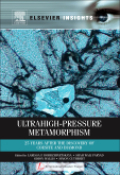
Ultrahigh pressure metamorphism: 25 years after the discovery of coesite and diamond
Dobrzhinetskaya, Larissa
Faryad, Shah Wali
Cuthbert, Simon
Wallis, Simon
Ultrahigh pressure metamorphism (UHPM) is a relatively new but fast growing discipline related to the deep subduction of slabs of continental and/or oceanic crust into the Earth's mantle and their return towards the surface as important components of mountain belts. The discipline was established ~25 years agoafter discoveries of high pressure minerals, coesite and diamond, in the rocks of the continental affinities, a place where such minerals are "forbiden"according to main geological concepts. Exposures of HP/UHP rocks, once thought tobe restricted to European Mountain systems, are being found in Asia, Africa, South and North Americas and Greenland. They provide us with valuable information on the mineral assemblages, fluid inclusions, microstructures, rheologies,major and trace element chemistries, stable and radiogenic isotope characteristics and timing relationships in slabs that have been subducted to depth up to some 200-250 km. Geologic processes under UHP conditions are by their very nature difficult to unravel because of the intense overprinting experienced by the rocks on their way back up to the Earth's surface. However, detailed studies in outcrops and in mineral/rock slides in laboratories with the aid of advanced state-of-art analytical instruments and techniques provide unprecedented integrated knowledge about processes operating in deep Earth's horizons at converging plate boundaries. UHPM rocks consist of the fragments of continental and oceanic crustal rocks and associated mafic-ultramafic intrusions and/or mantle peridotite initially formed at shallow lithosphere, but which subsequentlyhave experienced a recrystallization within or above coesite and diamond stability fields (>2.7 - 4 GPa, ~700 - 1000oC). Before coesite and diamond discoveries, the eclogites and peridotites that are characteristic of UHPM terranes were considered geological curiosities of limited occurrence and significance. The number of Geoscientists working on HP/UHP and related rocks has been increasing steadily each year as their significance has become more and more apparent, numbering now several hundred extremely active international scientists.The current explosion of research on UHPM terranes reflects their significance for understanding large scale mantle dynamics, major elements of plate tectonics such as continental collisions, deep subduction and exhumation, mountains building, geochemical recycling "from surface to the core", and a deep storage of light elements participating in green-house effects in the atmosphere. FEATURE - an extensive and wide-ranging collection of up-to-the-minute research papers, with many of the authors being major practitioners in the discipline of ultra-high pressure metamorphic geoscience and the geodynamics and processes operating in the deep levels of convergent tectonic geosystems. BENEFIT - an important, authoritative and comprehensive "one-stop"resource for the growing UHPM research community and an excellent introduction to the subject for graduatestudents, geological survey, mining and resources planning workers, and academics wishing to participate in this exciting and dynamic field of research, orseeking a wider perspective on related fields of investigation. 2. FEATURE - a forward-looking approach founded upon a detailed historical perspective on UHPM geoscience over twenty-five years, including a comprehensive reference list. BENEFIT- as we stand at a crucial juncture in UHPM studies when the period of exploration and discovery passes into a phase of consolidation and recognition of the significance of UHPM rocks for the wider Earth system, readers can follow the trends in discovery, methodology and theory over the last three decades, gain a clear impression of the current trends and look ahead to the approaches that will shape the science in the future. 3. FEATURE - a highly diverse set of articles covering a wide range of methods and sub-disciplines from micro- and nano-scale mineralogy, advanced instrumental methods, isotopic analysis, petrology geochemistry, geofluids, structural geology, tectonics and geophysics from well-known and frontier locations, all relating to subduction and mantle systems that are fundamental to the dynamics and evolution of the Earth system. BENEFIT - the book will be of interest to practitioners in a wide range of sub-disciplines in the geosciences and deep geophysics covering deep subduction processes, mountains building, re-shaping the Earth's continents configuration in the past, formation of the orogenic belts worldwide and across the span of geological time from the Archaean to the present day; in addition to the applications to UHPM studies, readers will undoubtedly find material relevant to their own interests well beyond UHPM rocks.
- ISBN: 978-0-12-385144-4
- Editorial: Elsevier Science
- Encuadernacion: Cartoné
- Páginas: 700
- Fecha Publicación: 01/03/2011
- Nº Volúmenes: 1
- Idioma: Inglés
